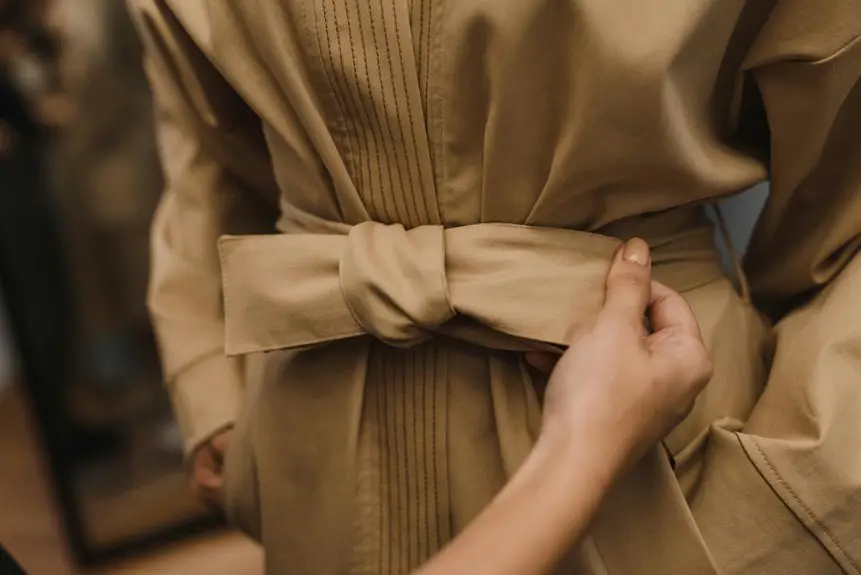To sew acetate fabric flawlessly, start with a fine sharp needle (60/8 or 70/10) and lightweight polyester or silk thread to avoid puckering. Pre-wash the fabric, cut on a flat surface using sharp scissors, and use pattern weights instead of pins. Choose medium stitch length with slightly lowered tension and stabilize fabric with clips or water-soluble stabilizers. Press seams gently with a low-heat iron and a pressing cloth. Handle seams carefully to prevent fraying and puckering. Keep going to discover more expert tips for perfect results.
Table of Contents
Key Takeaways
- Use a fine Microtex needle (size 60/8 or 70/10) and lightweight polyester or silk thread for smooth, snag-free stitching on acetate fabric.
- Pre-wash acetate, handle wrinkles with gentle steaming or a low-heat iron using a pressing cloth to avoid fabric damage.
- Cut acetate with sharp scissors on a flat surface and stabilize with pattern weights or tissue paper instead of pins.
- Employ French seams or Hong Kong finish to enclose raw edges, preventing fraying and giving a clean, durable finish.
- Press seams gently with low heat and a pressing cloth, avoiding direct iron contact to prevent melting or distortion.
Selecting the Right Needle and Thread for Acetate
Choosing the right needle and thread is essential when sewing acetate fabric to guarantee clean stitches and prevent damage.
Selecting the proper needle and thread ensures smooth, damage-free stitches on delicate acetate fabric.
You should use a fine, sharp needle, like a size 70/10 or 60/8, to avoid snagging or leaving large holes. A microtex or sharp needle works best because acetate is delicate and can easily show needle marks.
For thread, opt for a lightweight polyester or silk thread. These threads offer strength without adding bulk, helping your seams lay smoothly.
Avoid heavy or coarse threads, as they can create puckering or damage the fabric’s surface.
Preparing Acetate Fabric Before Sewing
Before you start sewing, make sure to pre-wash your acetate fabric to prevent shrinkage later on.
Handle wrinkles carefully by using a low-heat iron or steaming to avoid damage.
When cutting, use sharp scissors and a steady hand to keep the edges clean and precise.
Pre-washing Techniques
Although acetate fabric is delicate, you can prepare it effectively by using the right pre-washing techniques to prevent shrinkage and color loss. Start by testing a small fabric swatch to check colorfastness. Use cold water and a gentle detergent to hand wash, avoiding agitation. Rinse thoroughly, then lay flat to dry away from direct sunlight to preserve fabric integrity.
| Step | Action |
|---|---|
| 1. Test Swatch | Check colorfastness with water |
| 2. Use Cold Water | Prevents shrinkage |
| 3. Gentle Detergent | Protects fabric fibers |
| 4. Air Dry | Avoids heat damage |
Following these steps guarantees your acetate fabric stays vibrant and ready for flawless sewing.
Handling Fabric Wrinkles
When you handle acetate fabric wrinkles carefully, you’ll secure a smooth surface that’s easier to sew.
Start by gently steaming the fabric rather than using a hot iron directly, as acetate is sensitive to heat and can melt. Hold the steamer a few inches away, moving it evenly across the wrinkled areas.
If you don’t have a steamer, place a pressing cloth between the fabric and a warm iron, using the lowest heat setting. Avoid applying too much pressure or leaving the iron in one spot. Always test on a scrap piece first to prevent damage.
After steaming, let the fabric cool flat to maintain smoothness. Proper wrinkle handling secures your acetate pieces align perfectly and sew without puckering or distortion.
Cutting Tips
Cutting acetate fabric requires careful attention to prevent slipping and fraying. To start, lay your fabric on a flat, clean surface, and secure it with pattern weights instead of pins to avoid shifting.
Use a sharp rotary cutter or fine, sharp fabric scissors for crisp edges. Before cutting, consider placing tissue paper underneath the fabric to stabilize it, reducing movement. Always cut slowly and steadily, following your pattern lines precisely.
Avoid lifting the fabric while cutting, as this can cause distortion. If your acetate has a nap or shine, cut all pieces facing the same direction to maintain consistency.
Finally, handle cut pieces gently to prevent fraying before sewing, and consider applying a lightweight spray starch to add firmness if needed.
Cutting Techniques to Prevent Slippage
When cutting acetate fabric, you’ll want to use sharp scissors to guarantee clean edges and prevent snagging.
Using pattern weights instead of pins keeps the fabric steady without causing damage.
Always cut on a flat surface to maintain control and avoid slippage.
Use Sharp Scissors
Although acetate fabric can be slippery, using sharp scissors makes all the difference in achieving clean, precise cuts. Dull scissors tend to snag or drag the fabric, causing uneven edges and frustrating your sewing process.
Make sure your scissors are dedicated to fabric only, as cutting paper or other materials dulls the blades quickly. Before you start, check the sharpness by slicing through a scrap piece; if you feel resistance, sharpen or replace them.
Sharp scissors glide smoothly, allowing you to follow your pattern lines accurately without shifting the fabric. This precision reduces mistakes and saves time during sewing.
Employ Pattern Weights
To keep acetate fabric from slipping while you cut, you’ll want to employ pattern weights instead of pins. Pins can leave permanent holes or distort the delicate fibers, so weights offer a safer hold.
Place your pattern weights evenly around the edges of the pattern pieces to secure the fabric firmly. Use smooth, flat weights like metal or acrylic ones to avoid snagging the fabric.
Adjust the weights as you cut, ensuring the fabric stays taut but not stretched. This method not only prevents shifting but also helps maintain the fabric’s smooth surface, giving you clean, precise cuts.
Cut on Flat Surface
Choose a large, flat surface to cut your acetate fabric, ensuring it stays stable and prevents any unwanted slipping. A sturdy table or cutting mat works best to keep the fabric smooth and flat. Avoid uneven or soft surfaces that can cause shifting and inaccurate cuts. Remember to secure your fabric with pattern weights or pins before cutting. Using sharp scissors or a rotary cutter will also give you clean edges without snagging the delicate fibers.
| Surface Type | Stability Level | Best Use Case |
|---|---|---|
| Sturdy Table | High | Ideal for precision cuts |
| Cutting Mat | High | Protects surface, easy to cut |
| Carpeted Floor | Low | Not recommended |
| Upholstered Chair | Low | Causes fabric slippage |
| Hard Floor | Medium | Use with caution |
Using the Appropriate Stitch Length and Tension
When you sew acetate fabric, adjusting your stitch length and tension is crucial to prevent puckering or damaging the delicate fibers. Set your stitch length to a medium setting, around 2.5 to 3 millimeters, to avoid creating holes or weakening the fabric.
Too short stitches can cause the acetate to gather and pucker, while too long stitches may not hold seams securely. Next, lower your machine’s tension slightly compared to what you use for woven cottons. This adjustment helps prevent thread breakage and fabric distortion.
Always test these settings on a fabric scrap before sewing your project. Fine-tuning stitch length and tension guarantees smooth, even seams and preserves the fabric’s elegant drape and sheen without risking damage.
Stabilizing Acetate to Avoid Shifting
Since acetate fabric tends to shift easily during sewing, stabilizing it’s essential for accurate seams and a polished finish.
To keep your fabric steady, start by using sharp pins or clips to hold layers firmly in place. Pin perpendicular to the seam line for easy removal as you sew. You might also consider a lightweight, water-soluble stabilizer; it adds grip without damaging delicate acetate.
When cutting, use a rotary cutter with a ruler on a cutting mat for cleaner edges that won’t slip. Additionally, pressing your fabric gently with a low-heat iron before sewing helps reduce movement.
Taking these steps will help you control acetate’s slippery nature, ensuring your sewing stays precise and your finished project looks professional.
Choosing the Best Seam Finishes for Acetate
When working with acetate, choosing the right seam finish can make all the difference in your garment’s durability and appearance.
You’ll find that French seams offer a clean, elegant look while preventing fraying, perfect for delicate fabrics.
Alternatively, the Hong Kong finish adds a colorful, professional edge that’s both sturdy and stylish.
French Seams Benefits
Although acetate fabric can be slippery and delicate, you’ll find that French seams offer a neat, durable finish that protects the fabric’s edges from fraying. This technique encloses raw edges, making your garment look professional and increasing its lifespan. French seams also reduce bulk, which is ideal for acetate’s lightweight nature. You’ll appreciate how this finish adds strength without compromising the fabric’s drape.
| Benefit | Why It Matters | Tip for Sewing |
|---|---|---|
| Neat Finish | Keeps edges hidden and clean | Sew with light tension and fine thread |
| Durable | Prevents fraying over time | Use two-step stitching for strength |
| Reduced Bulk | Maintains fabric’s flow | Trim seam allowance before second stitch |
| Professional Look | Enhances overall garment quality | Press seams flat between steps |
Hong Kong Finish Advantages
French seams give your acetate garment a clean, strong edge, but sometimes you want a finish that’s lighter and more flexible.
That’s where the Hong Kong finish shines. By enclosing the raw edges with bias tape, it prevents fraying without adding bulk, which is perfect for acetate’s delicate nature.
You’ll find this finish adds a polished, professional look, especially on unlined garments or pieces where the seams are visible. It’s also quicker than French seams, saving you time without sacrificing durability.
Plus, the bias tape can match or contrast your fabric, giving you creative freedom.
When you use the Hong Kong finish, your acetate seams stay smooth and strong, maintaining the fabric’s elegant drape and sheen.
It’s an excellent choice for a flawless acetate project.
Pressing Tips to Protect the Fabric
Since acetate fabric is sensitive to heat, you’ll need to adjust your pressing techniques to avoid damage.
Always set your iron to the lowest heat setting suitable for synthetics, and avoid using steam directly on the fabric, as moisture combined with heat can cause water spots or shrinkage.
Use a pressing cloth to create a protective barrier between the iron and the fabric, preventing shine or melting.
Press gently without sliding the iron back and forth to avoid stretching or distorting the fabric.
When pressing seams, apply light pressure and lift the iron between presses rather than dragging it.
Always test your iron settings on a scrap piece before pressing your garment to verify you won’t ruin your project.
These steps will help you maintain acetate’s smooth, sleek finish.
Handling Seams and Hems With Care
When you handle seams and hems on acetate fabric, you need to sew slowly and carefully to prevent puckering or stretching.
Use a fine needle, like size 60/8 or 70/10, and opt for a short stitch length to secure the seams firmly without damaging the delicate fibers.
Pin edges gently or use fabric clips to keep layers aligned without causing marks.
Press seams open or to one side with a low heat setting and a pressing cloth to avoid shine or burns.
For hems, consider a narrow rolled hem or a double-fold hem to achieve a clean finish that won’t fray.
Taking these steps guarantees your acetate garment maintains a smooth, professional look without distortion.
Avoiding Common Pitfalls When Sewing Acetate
Although acetate fabric offers a beautiful drape and sheen, it demands extra attention to avoid common sewing mistakes. You’ll want to prevent puckering, slipping, and melting to guarantee a flawless finish. Use sharp needles and test stitches on scraps first. Avoid high heat on your iron and sewing machine to protect the fabric’s integrity.
| Pitfall | Cause | Solution |
|---|---|---|
| Puckering | Tight tension | Loosen thread tension |
| Slipping seams | Smooth surface | Use pins or fabric clips |
| Needle holes | Dull needles | Switch to a new, sharp needle |
| Melting fabric | High heat from iron | Use low heat or press cloth |
Being mindful of these pitfalls will help you sew acetate with confidence and precision.
Tips for Maintaining Your Finished Acetate Garments
Because acetate fabric requires delicate handling during sewing, you’ll need to take special care when maintaining your finished garments.
Always check the care label, but generally, hand washing in cold water with a mild detergent is safest. Avoid wringing or twisting the fabric; instead, gently press out excess water with a towel.
Hand wash acetate in cold water with mild detergent, avoiding wringing; gently press out water with a towel.
When drying, lay your garment flat on a clean surface away from direct sunlight to prevent fading and distortion. If you need to iron, use a low heat setting and place a pressing cloth between the iron and fabric to avoid melting or shiny marks.
Store acetate garments in a cool, dry place on padded hangers to maintain shape and prevent creases. Following these tips will keep your acetate pieces looking fresh and beautiful for longer.
Frequently Asked Questions
Can Acetate Fabric Be Machine Washed or Does It Require Dry Cleaning?
You usually can’t machine wash acetate fabric because it may shrink or lose shape. Instead, you should dry clean it or hand wash gently in cold water to keep it looking its best without damage.
What Types of Garments Are Best Suited for Acetate Fabric?
You’ll find acetate fabric perfect for elegant dresses, blouses, linings, and scarves. Its smooth texture and drape work well for formal and lightweight garments, giving you a polished, luxurious finish every time you wear them.
How Does Acetate Fabric Behave When Exposed to Sunlight Over Time?
Did you know acetate fabric can lose up to 50% of its strength after prolonged sunlight exposure? You’ll notice it weakens and fades over time, so protect your acetate garments from direct sunlight to keep them looking great.
Are There Eco-Friendly Alternatives to Acetate Fabric?
You can choose eco-friendly alternatives like Tencel, organic cotton, or hemp, which are biodegradable and sustainably produced. These fabrics offer great breathability and durability while reducing environmental impact compared to acetate’s synthetic origins.
Can Acetate Fabric Be Dyed at Home Effectively?
Did you know 70% of acetate fabrics can absorb dye unevenly? You can dye acetate at home, but expect some blotchiness. Use disperse dyes and heat for better results, and test a small swatch first.
- Why Open-Weave Scrim Is the Secret to Stunning Event and Canopy Designs - June 26, 2025
- Creating Large-Scale Art Installations With Scrim Fabric - June 26, 2025
- Scrim Fabric in Upholstery: Understanding Its Use as a Backing Material - June 26, 2025







